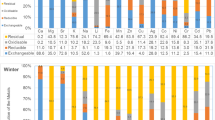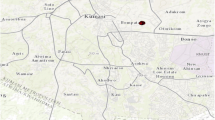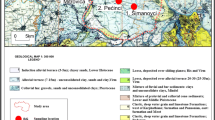Abstract
The upsurge in agricultural food demand due to population explosion and urbanization has great impact on the quality of soil. Therefore, the present study was aimed to assess the contamination and pollution by selected metals (Ca, Cd, Co, Cr, Cu, Fe, K, Li, Mg, Mn, Na, Ni, Pb and Zn) in the soil of typical rural and urban farmlands. The metal contents were quantified by atomic absorption spectrometry employing wet acid digestion methodology. In addition, physicochemical parameters (pH, redox potential, EC, TDS, organic matter, moisture, density, porosity and total alkalinity), anion levels (sulphate, chloride, nitrate and nitrite) and soil texture was also evaluated. Average concentrations of Co, Na, Ni, Pb and Zn were significantly higher in the rural soil, while Ca, Cu and Mg contents were considerably higher in the urban soil (p < 0.05). The correlation study revealed significantly divergent association among the metals in both categories of soil samples. Soil texture mostly revealed sandy loam nature of the soil with higher clay and silt contents in urban soil and elevated sand contents in rural soil which was predominantly Ca–Mg–HCO3 in composition. Significant anthropogenic contribution was shown by the cluster analysis while enrichment factors and contamination factors revealed severe to very high enrichment and moderate contamination of Cd and Pb in the soil. The study showed that elevated levels and anthropogenic enrichment of the metals in agricultural soil could pose serious health risks which should be addressed by appropriate management and sustainable agricultural practices.



Similar content being viewed by others
References
Abrahim GMS, Parker RJ (2008) Assessment of heavy metal enrichment factors and the degree of contamination in marine sediments from Tamaki estuary, Auckland, New Zealand. Environ Monit Assess 136:227–238
Al-Rashdi TT, Sulaiman H (2015) Assessment of physiochemical properties of farm soils and irrigation water around a major industrial area in Oman. Proc Environ Sci 28:265–270
Ander EL, Johnson CC, Cave MR, Palumbo-Roe B, Nathanail CP, Lark RM (2013) Methodology for the determination of normal background concentrations of contaminants in English soil. Sci Total Environ 454–455:604–618
Arain MB, Kazi TG, Jamali MK, Jalbani N, Afridi HI, Baig JA (2008) Speciation of heavy metals in sediment by conventional, ultrasound and microwave assisted single extraction methods: a comparison with modified sequential extraction procedure. J Hazard Mater 154:998–1006
Arora M, Kiran B, Rani S, Rani A, Kaur B, Mittal N (2008) Heavy metal accumulation in vegetables irrigated with water from different sources. Food Chem 111:811–815
Arrobas M, Lopes H, Rodrigues MA (2017) Urban agriculture in Braganca, Northeast Portugal: assessing the nutrient dynamic in the soil and plants, and their contamination with trace metals. Biol Agric Hortic 33:1–13
ASTM (1998) Standard test method for particle size analysis of soils. American Society for Testing and Materials, West Conshohocken
Babcock M, Shukla MK, Picchioni GA, Mexal JG, Daniel D (2009) Chemical and physical properties of Chihuahuan desert soils irrigated with industrial effluent. Arid Land Res Manag 23:47–66
Borkar AD (2015) Studies on some physicochemical parameters of soil samples in Katol Taluka District Nagpur (MS), India. Res J Agric For Sci 3:16–18
Brevik EC, Fenton TE, Horton R (2004) Effect of daily soil temperature fluctuations on soil electrical conductivity as measured with the Geonics EM-38. Precis Agric 5:145–152
Carter MR, Gregorich EG (2007) Soil sampling and methods of analysis, 2nd edn. Canadian Society of Soil Science, CRC Press, Boca Raton
Chary NS, Kamala CT, Raj DSS (2008) Assessing risk of heavy metals from consuming food grown on sewage irrigated soils and food chain transfer. Ecotoxicol Environ Saf 69:513–524
da Silva FBV, do Nascimento CWA, Araujo PRM, da Silva FL, Lima LHV (2017) Soil contamination by metals with high ecological risk in urban and rural areas. Int J Environ Sci Technol 14:553–562
Dragovic S, Mihailovi N (2009) Analysis of mosses and topsoil’s for detecting sources of heavy metal pollution: multivariate and enrichment factor analysis. Environ Monit Assess 157:383–390
Duan L, Song J, Xu Y, Li X, Zhang Y (2010) The distribution, enrichment and source of potential harmful elements in surface sediments of Bohai Bay, North China. J Hazard Mater 183:155–164
Duruibe JO, Ogwuegbu MDC, Egwurugwu JN (2007) Heavy metal pollution and human biotoxic effects. Int J Phys Sci 2:112–118
Facchinelli A, Sacchi E, Mallen I (2001) Multivariate statistical and GIS- based approach to identify heavy metal sources in soils. Environ Pollut 114:245–276
Gil C, Boluda R, Martin JAR, Guzman M, del Moral F, Ramos-Miras J (2018) Assessing soil contamination and temporal trends of heavy metal contents in greenhouses on semiarid land. Land Degrad Dev 29:3344–3354
Greve MH, Kheir RB, Greve MB, Bocher PK (2012) Quantifying the ability of environmental parameters to predict soil texture fractions using regression-tree model with GIS and LIDAR data: the case study of Denmark. Ecol Ind 18:1–10
Hakanson L (1980) An ecological risk index for aquatic pollution control: a sedimentological approach. Water Res 14:975–1001
Hijbeek R, Pronk AA, Ittersum MKV, Tenberge HFM, Bijttebier J, Verhagen A (2018) What drives farmers to increase soil organic matter? Insights from The Netherlands. Soil Use Manag 34:85–100
Husson O, Husson B, Brunet A, Babre D, Alary K, Sarthou JP, Charpentier H, Durand M, Benada J, Henry M (2016) Practical improvements in soil redox potential (Eh) measurement for characterisation of soil properties. Application for comparison of conventional and conservation agriculture cropping systems. Anal Chim Acta 906:98–109
Kashem MDA, Singh BR, Kawai S (2006) Mobility and distribution of cadmium, nickel and zinc in contaminated soil profiles from Bangladesh. Nutr Cycl Agroecosyst 77:187–198
Khan S, Cao Q, Zheng YM, Huang YZ, Zhu YG (2008) Health risks of heavy metals in contaminated soils and food crops irrigated with wastewater in Beijing, China. Environ Pollut 152:686–692
Khan S, Rehman S, Khan AZ, Khan MA, Shah MA (2010) Soil and vegetables enrichment with heavy metals from geological sources in Gilgit, northern Pakistan. Ecotoxicol Environ Saf 73:1820–1827
Lestariningsih ID, Hairiah WK (2013) Assessing soil compaction with two different methods of soil bulk density measurement in oil palm plantation soil. Proc Environ Sci 17:172–178
Li XD, Lee SL, Wong SC, Shi WZ, Thornton I (2004) The study of metal contamination in urban soil of Hong Kong using a GIS base approach. Environ Pollut 129:113–124
Mcllwaine R, Cox SF, Doherty R, Palmer S, Ofterdinger U, McKinley JM (2014) Comparison of methods used to calculate typical threshold values for potentially toxic elements in soil. Environ Geochem Health 36:953–971
MEF (2007) Government decree on the assessment of soil contamination and remediation needs (214/2007). Ministry of the Environment, Finland
Oumenskou H, El Baghdadi M, Barakat A, Aquit M, Ennaji W, Karroum LA, Aadraoui M (2018) Assessment of the heavy metal contamination using GIS-based approach and pollution indices in agricultural soils from Beni Amir irrigated perimeter, Tadla plain, Morocco. Arab J Geosci 11:692
Pansu M, Gautheyrou J (2007) Handbook of soil analysis: mineralogical, organic and inorganic methods. Springer, The Netherlands
Pennisi G, Orsini F, Gasperi D, Mancarella S, Sanoubar R, Antisari LV, Vianello G, Gianquinto G (2016) Soilless system on peat reduce trace metals in urban-grown food: unexpected evidence for a soil origin of plant contamination. Agron Sustain Dev 36:56
Radojevic M, Bashkin VN (1999) Practical environmental analysis. Royal Society of Chemistry, Cambridge
Reimann C, de Caritat P (2017) Establishing geochemical background variations and threshold values for 59 elements in Australian surface soil. Sci Total Environ 578:633–648
Romic M, Romic D (2003) Heavy metals distribution in agricultural top soils in urban area. Environ Geol 43:795–805
Rousk J, Baath E, Brookes CP, Lauber LC, Catherine (2010) Soil bacterial and fungal communities across a pH gradient in an arable soil. ISME J 10:1–12
Shah MT, Begum S, Khan S (2010) Pedo and biogeochemical studies of mafic and ultramafic rocks in the Mingora and Kabal areas, Swat, Pakistan. Environ Earth Sci 60:1091–1102
StatSoft (1999) STATISTICA for windows. Computer Program Manual, Tulsa, OK
Sutherland RA (2000) Bed-sediment-associated trace metals in an urban stream, Oahu Hawaii. Environ Geol 39:611–627
Toth G, Hermann T, Da Silva MR, Montanarella L (2016a) Heavy metals in agricultural soils of the European Union with implications for food safety. Environ Int 88:299–309
Toth G, Hermann T, Szatmari G, Pasztor L (2016b) Maps of heavy metals on the soils of the European Union and proposed priority areas for detailed assessment. Sci Total Environ 565:1054–1062
Turkdogan MK, Fevzi K, Kazim K, Ilyas T, Ismail U (2003) Heavy metals in soil, vegetables and fruits in the endemic upper gastrointestinal cancer region of Turkey. Environ Toxicol Pharmacol 13:175–179
Vega FA, Covelo EF, Cerqueira B, Andrade ML (2009) Enrichment of marsh soils with heavy metals by effect of anthropic pollution. J Hazard Mater 170:1056–1063
Wang G, Su MY, Chen YH, Lin FF, Luo D, Gao SF (2006) Transfer characteristics of cadmium and lead from soil to the edible parts of six vegetable species in southeastern China. Environ Pollut 144:127–135
Wu YG, Xu YN, Zhang JH, Hu SH (2010) Evaluation of ecological risk and primary empirical research on heavy metals in polluted soil over Xiaoqinling gold mining region, Shaanxi, China. Trans Nonferrous Metals Soc China 20:688–694
Zhao J, Wang X, Shao Y, Xu G, Fu S (2011) Effects of vegetation removal on soil properties and decomposer organisms. Soil Biol Biochem 43:954–960
Acknowledgements
Financial and technical help provided by Quaid-i-Azam University, Islamabad, Pakistan to carry out this project is thankfully acknowledged.
Author information
Authors and Affiliations
Corresponding author
Ethics declarations
Conflict of interest
There is no conflict of interests towards the publication of this research paper.
Additional information
Publisher’s Note
Springer Nature remains neutral with regard to jurisdictional claims in published maps and institutional affiliations.
Electronic supplementary material
Below is the link to the electronic supplementary material.
Rights and permissions
About this article
Cite this article
Shah, M.H., Ilyas, A., Akhter, G. et al. Pollution assessment and source apportionment of selected metals in rural (Bagh) and urban (Islamabad) farmlands, Pakistan. Environ Earth Sci 78, 189 (2019). https://doi.org/10.1007/s12665-019-8198-z
Received:
Accepted:
Published:
DOI: https://doi.org/10.1007/s12665-019-8198-z




